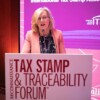
Interview with an ITSA Member – Garsu Pasaulis
14 Jun 2023 | Interviews
This month, we continue our series of interviews with members of the International Tax Stamp Association (ITSA), who share their experiences of the tax stamp industry and look ahead to some of the challenges and opportunities yet to come.
We began the series in the February issue, talking to Gerben van Wijk of Luminescence Sun Chemical Security, who is also Chairman of ITSA. Our second interview is with two members of the high-security printing company Garsu Pasaulis.
 |
 |
| Karolis Andriuškevičius | Andrius Lukoševičius |
Andrius Lukoševičius is Director of Garsu Pasaulis’s Security Printing Division. Having joined more than 20 years ago, he has been present for nearly the full span of the company’s time working with tax stamps, national documents, and other security printing projects.
Karolis Andriuškevičius joined as Project Manager ten years ago, with duties including the initiation and development of new business opportunities, plus working alongside contracting authorities to develop public procedures.
Q: Please would you introduce your company?
A: Garsu Pasaulis UAB is a high-security printer and system integrator based in Lithuania, supplying secure documents and personalisation solutions around the world. Our product portfolio includes excise, revenue and duty stamps and their related track and trace systems; passports and identity cards with full integration of related hardware and software systems; visas, driving licences, vehicle registration certificates and assorted other items requiring high-security printing.
Q: What makes your company stand out?
A: We are an experienced partner to governments looking to combat tax revenue loss related to counterfeit and smuggled goods such as alcohol, tobacco and other taxable goods. We deliver products to over 50 countries, with full certification including relevant ISO standards, national security printing licences and EU and NATO security clearance.
We supply over one billion tax stamps annually! Additionally, all of our production processes take place under ‘one roof’, with no subcontracting, and one benefit of this is the agility and flexibility to react quickly and fulfil urgent delivery requirements.
Q: What role does your company play in the tax stamp industry?
A: Since 2000, we have offered printing of duty, excise, and revenue stamps to, among many others, the United Nations Postal Administration, Lithuania, Azerbaijan, Latvia, Malta, Georgia, Armenia, Nepal, Slovenia, Sri Lanka, Kosovo, Kenya, Rwanda, and Uganda. During our time in the industry, we have delivered over 20 billion tax stamps in addition to providing numerous quality and security assurance systems, plus track and trace systems.
Q: What do you think is the most interesting aspect of tax stamps and/or the industry?
A: Each country has its own tax stamp programme and its own way of operating. Working in this industry offers us the opportunity to not only reflect on the differences between the programmes – including their ongoing changes and development – but also to be a driving force of positive change, which is exciting.
Q: What changes have you seen in the tax stamp industry during your time working in it?
A: The meaning, role and even definition of tax stamps have evolved and expanded over our 20-plus years in the industry.
As well as stamps serving as visible proof of tax payment, they provide a visible guarantee that the product is genuine, act as an anti-tampering and anti-reuse seal, and can even carry serialised codes for item-level production monitoring and supply chain track and trace procedures.
Also, in addition to stamps traditionally being applied to alcohol and tobacco products, governments are initiating programmes to apply them to medical products, non-alcoholic beverages, textiles, sugar, oil, cement and more. We are seeing considerable growth in the range of applications.
Finally, we have also observed a steady rise in discussions around and demand for track and trace solutions.
Q: What changes do you envisage happening within the industry in future?
A: We foresee the introduction of direct marking programmes starting to compete with existing physical paper stamp programmes, and increasing demand for authenticity verification via mobile devices. As the role of traditional security features on tax stamps diminishes, it also seems likely they will increasingly become carriers of more complex information.
Q: What is one change to tax stamps or the industry you would like to see?
A: We would like to see more clarity, transparency, and interoperability between different tax stamp programmes internationally.
Q: What do you see as the main challenges within the industry today?
A: A major challenge is the intensifying competition between tax stamps and direct marking solutions. Our concern is that this will raise the risk of sacrifices being made in terms of quality and security.
On a related note, the introduction of tax stamp programmes to countries that do not yet have them can be negatively influenced by lobbying and strong political intentions.
The rise in demand for track and trace solutions has also brought with it some new challenges, with one example being cases in which several suppliers are delivering different solutions within the same country.
Another example is that the introduction of track and trace solutions typically requires significant initial investments, which can only be recouped gradually, over long periods of time. Unfortunately, most stamp contracts are relatively short-term (often around one to three years).
Additionally, track and trace must be properly supported with legislation and public enforcement, and in some cases, sufficient government and industry support are simply not present.
Q: Why do you think the development of standards is important for the industry?
A: Of course, all the challenges we mentioned bring with them opportunities for change and improvement, and standardisation is key to making such positive progress.
Standards provide valuable guidance and set the benchmarks for a wide variety of products, operations, and platforms. They promote best industry practices, emphasising security and quality control – which, as we mentioned before, is likely to become even more of a concern as the industry grows and diversifies – and they reflect the shared values, aspirations, and responsibilities we all bear.
In our experience, staying informed and up-to-date with developments in standardisation can also drive innovation.







